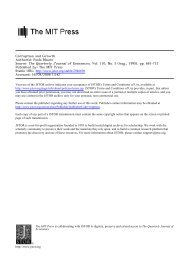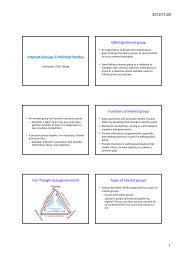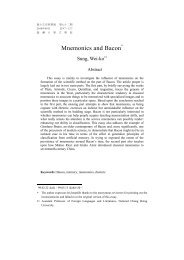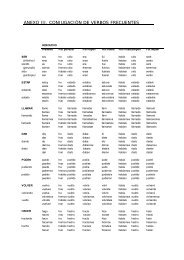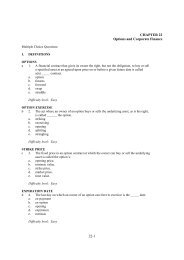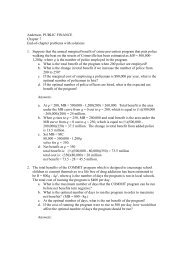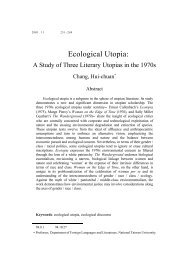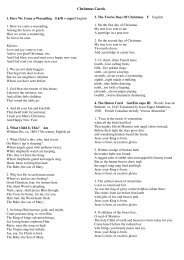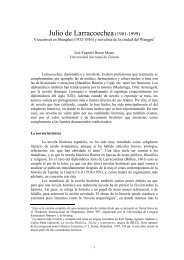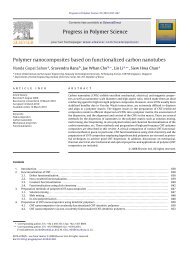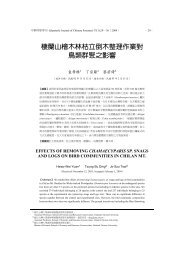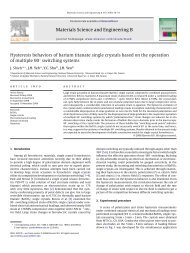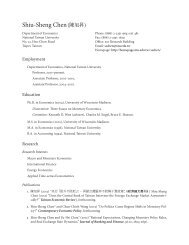Hands-on Exercise 3 Molecular Dynamics Simulations
Hands-on Exercise 3 Molecular Dynamics Simulations
Hands-on Exercise 3 Molecular Dynamics Simulations
You also want an ePaper? Increase the reach of your titles
YUMPU automatically turns print PDFs into web optimized ePapers that Google loves.
Computati<strong>on</strong>al Chemistry in Chemical Engineering<br />
stlin@ntu.edu.tw 2009<br />
<str<strong>on</strong>g>Hands</str<strong>on</strong>g>-<strong>on</strong> <strong>Exercise</strong> 3<br />
<strong>Molecular</strong> <strong>Dynamics</strong> Simulati<strong>on</strong>s<br />
1.General MD procedure<br />
2.Force Field Opti<strong>on</strong>s in MS 4.4<br />
3.Energy Minimizati<strong>on</strong><br />
4.<strong>Dynamics</strong> Simulati<strong>on</strong>s<br />
5.Analysis of MD results<br />
6.C<strong>on</strong>tinue from a previous simulati<strong>on</strong> run<br />
7.Create Animati<strong>on</strong><br />
Page 1<br />
stlin@ntu.edu.tw
1. General MD Procedure<br />
A complete molecular simulati<strong>on</strong> involves 5 steps<br />
1. Model Building<br />
• create the molecular model of interest<br />
2. Selecti<strong>on</strong> of an appropriate Force Field<br />
• simulati<strong>on</strong> results may heavily depend <strong>on</strong> FF<br />
3. Model Refinement<br />
• perform energy minimizati<strong>on</strong> to remove VDW<br />
repulsi<strong>on</strong>s in the initial structure<br />
• equilibrate the model at the desired state (T,P or T,V)<br />
with sufficient dynamics simulati<strong>on</strong>s<br />
4. <strong>Dynamics</strong> Simulati<strong>on</strong>s<br />
• producti<strong>on</strong> runs<br />
5. Result Analysis<br />
• calculati<strong>on</strong> of properties<br />
Page 2<br />
stlin@ntu.edu.tw
2. Force Field opti<strong>on</strong>s in Materials Studio<br />
There are two MD programs in Materials Studio<br />
1. Discover<br />
2. Forcite<br />
FF selecti<strong>on</strong> in Discover:<br />
Modules → Discover → Setup<br />
FF selecti<strong>on</strong> in Forcite:<br />
Modules → Forcite → Calculati<strong>on</strong><br />
Page 3<br />
stlin@ntu.edu.tw
Force Field Parameters<br />
Force Field<br />
Forcefield types<br />
Atomic charges<br />
Accuracy<br />
Page 4<br />
stlin@ntu.edu.tw
Examine Force Field Parameters<br />
Modules → Forcite → Forcefield Manager<br />
select a FF<br />
add to the<br />
project<br />
Page 5<br />
stlin@ntu.edu.tw
1. display<br />
document<br />
3. additi<strong>on</strong>al<br />
settings<br />
2. interacti<strong>on</strong><br />
parameters<br />
Page 6<br />
stlin@ntu.edu.tw
3. Energy minimizati<strong>on</strong> using Forcite<br />
Modules → Forcite → Calculati<strong>on</strong> → Setup → Geometry Optimizati<strong>on</strong><br />
medium<br />
accuracy is<br />
usually<br />
sufficient<br />
cell shape<br />
changes if<br />
checked<br />
too many<br />
iterati<strong>on</strong>s may<br />
take too much<br />
time<br />
Page 7<br />
useful to use moti<strong>on</strong> groups<br />
in initial minimizati<strong>on</strong><br />
stlin@ntu.edu.tw
Define Moti<strong>on</strong> Groups<br />
Modify → Moti<strong>on</strong> Groups<br />
Note: Use undo or delete to<br />
remove Moti<strong>on</strong> Groups<br />
Page 8<br />
stlin@ntu.edu.tw
Recap <strong>on</strong> Energy Minimizati<strong>on</strong> (Geometry Optimizati<strong>on</strong>)<br />
1. Choose a force field (check atom type, atomic charges)<br />
[Note that it is important to check if net charge of your<br />
model is zero]<br />
2. Choose c<strong>on</strong>vergence tolerance (when to stop the<br />
minimizati<strong>on</strong>) and maximum iterati<strong>on</strong> steps (stop no<br />
mater what)<br />
3. Whether to optimize the cell parameters (cell lengths and<br />
angles)<br />
4. Whether to keep some molecules rigid during the<br />
geometry optimizati<strong>on</strong><br />
Page 9<br />
stlin@ntu.edu.tw
4. <strong>Dynamics</strong> Simulati<strong>on</strong> using Forcite<br />
Modules → Forcite → Calculati<strong>on</strong> → Setup → <strong>Dynamics</strong><br />
ensemble<br />
initial atom velocity<br />
dynamic temperature<br />
dynamic pressure<br />
integrati<strong>on</strong> step<br />
simulati<strong>on</strong> length<br />
output frequency<br />
Page 10<br />
T c<strong>on</strong>trol method<br />
P c<strong>on</strong>trol method<br />
stlin@ntu.edu.tw
Recap <strong>on</strong> <strong>Dynamics</strong> Simulati<strong>on</strong>s<br />
1. Choose a force field (check atom type, atomic charges)<br />
[Note that it is important to check if net charge of your<br />
model is zero]<br />
2. Make sure the structure is stable (either previously<br />
energy minimized or having dynamics simulati<strong>on</strong><br />
performed)<br />
3. Set simulati<strong>on</strong> parameters (ensemble, initial velocity,<br />
dynamics temperature and thermostat, pressure and<br />
barostat, integrati<strong>on</strong> step, simulati<strong>on</strong> length, output<br />
property and frequency)<br />
Page 11<br />
stlin@ntu.edu.tw
<strong>Exercise</strong>:<br />
1. Create a 3D periodic cell c<strong>on</strong>taining 16 water molecules<br />
2. Assign atomic charges: -0.82 <strong>on</strong> oxygen and +0.41 <strong>on</strong> hydrogen<br />
3. Choose the Dreiding forcefield and perform energy minimizati<strong>on</strong><br />
4. Choose the Dreiding forcefield and Perform NPT dynamics for<br />
100 ps at T=300 K, P= 10 atm.<br />
5. Redo the <strong>Dynamics</strong> simulati<strong>on</strong> using the COMPASS forcefield<br />
Page 12<br />
stlin@ntu.edu.tw
5. Analysis of MD Results<br />
Basic properties you may obtain from doing MD Simulati<strong>on</strong>s<br />
1. Energetic Properties: valence energies (b<strong>on</strong>d, angle, torsi<strong>on</strong>,<br />
inversi<strong>on</strong>), n<strong>on</strong>b<strong>on</strong>d energies (vdW, Coulomb), potential, kinetic,<br />
and total energies, Hamilt<strong>on</strong>ian, etc.<br />
2. Mechanical properties: density, pressure (stress)<br />
3. Transport properties: diffusivity, thermal c<strong>on</strong>ductivity, viscosity<br />
4. Electrical properties: dielectric c<strong>on</strong>stant<br />
5. Structural properties: IR, radial distributi<strong>on</strong> functi<strong>on</strong>, X-ray<br />
diffracti<strong>on</strong>, neutr<strong>on</strong> diffracti<strong>on</strong>, electr<strong>on</strong> diffracti<strong>on</strong><br />
6. Thermodynamic properties: adiabatic compressibility, isothermal<br />
compressibility , thermal pressure coefficient, gruneisen parameter,<br />
isobaric heat capacity, isometric heat capacity, volume expansivity,<br />
isoenthalpic Joule-Thoms<strong>on</strong> coefficient, isothermal Joule-Thoms<strong>on</strong><br />
coefficient, speed of sound<br />
Page 13<br />
stlin@ntu.edu.tw
Basic Trajectory Informati<strong>on</strong><br />
use animati<strong>on</strong> toolbar to step through the trj file<br />
.xtd is the trj file<br />
sim. parameters<br />
.xcd files for<br />
energy, T,<br />
density, and cell<br />
The Trajectory<br />
menu provide<br />
current frame<br />
informati<strong>on</strong><br />
Page 14<br />
stlin@ntu.edu.tw
Advanced Analysis<br />
Modules → Forcite → Analysis<br />
Page 15<br />
stlin@ntu.edu.tw
6. C<strong>on</strong>tinue from a previous simulati<strong>on</strong> run<br />
1. select the trajectory (xtd) that you wish to c<strong>on</strong>tinue<br />
2. Modules → Forcite → Calculati<strong>on</strong> → Setup<br />
3. Check “Restart” and “Append to current trajectory”<br />
4. Run<br />
Page 16<br />
stlin@ntu.edu.tw
7. Create Animati<strong>on</strong> (Making movies)<br />
1. select the trajectory (xtd) from which the animati<strong>on</strong> will be created<br />
2. File → Export → Export type as “Movie Clip (*.avi)”<br />
3. Click <strong>on</strong> the “opti<strong>on</strong>” butt<strong>on</strong> to specify the movie parameters<br />
4. OK and Export<br />
Page 17<br />
stlin@ntu.edu.tw



